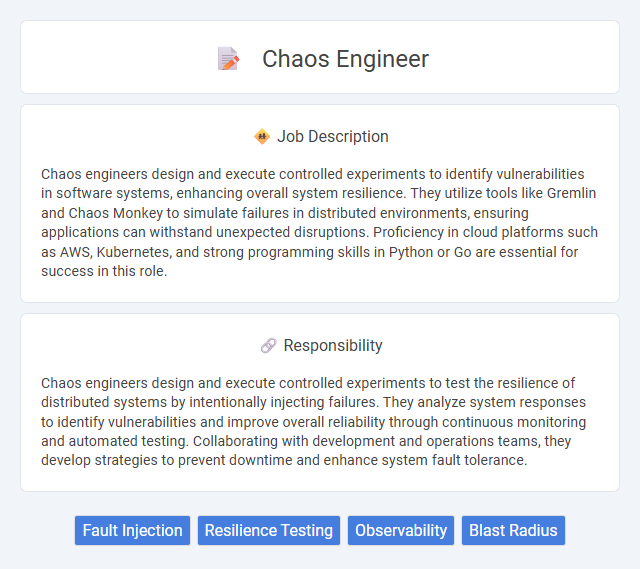
Chaos engineers design and execute controlled experiments to identify vulnerabilities in software systems, enhancing overall system resilience. They utilize tools like Gremlin and Chaos Monkey to simulate failures in distributed environments, ensuring applications can withstand unexpected disruptions. Proficiency in cloud platforms such as AWS, Kubernetes, and strong programming skills in Python or Go are essential for success in this role.
Individuals who thrive in Chaos Engineer roles often exhibit strong problem-solving skills and an affinity for working in high-pressure, unpredictable environments. Those comfortable with continuous learning and experimentation may find this job suitable, as it requires designing and executing fault injection tests to improve system resilience. It is likely that people who prefer structured and predictable tasks may find the dynamic nature of chaos engineering challenging.
Qualification
A Chaos Engineer typically holds a Bachelor's degree in Computer Science, Software Engineering, or a related field, combined with strong expertise in cloud platforms like AWS, Azure, or Google Cloud. Proficiency in programming languages such as Python, Go, or Java, alongside experience with automation tools like Terraform and Kubernetes, is essential for designing and executing fault injection experiments. Deep understanding of distributed systems, microservices architecture, and monitoring tools like Prometheus and Grafana enables the Chaos Engineer to identify system vulnerabilities and improve resilience effectively.
Responsibility
Chaos engineers design and execute controlled experiments to test the resilience of distributed systems by intentionally injecting failures. They analyze system responses to identify vulnerabilities and improve overall reliability through continuous monitoring and automated testing. Collaborating with development and operations teams, they develop strategies to prevent downtime and enhance system fault tolerance.
Benefit
Chaos engineering roles likely enhance system resilience by identifying weaknesses before failures occur, reducing downtime risks. Professionals in this field probably contribute to improving overall software reliability, leading to increased customer satisfaction and trust. The job may also offer opportunities for continuous learning and innovation, fostering advanced problem-solving skills.
Challenge
Chaos engineer roles likely present significant challenges due to the need to create controlled failures in complex systems to test resiliency. They probably require deep understanding of distributed architectures and the ability to anticipate unpredictable system behaviors. The position may demand continuous learning and innovative problem-solving to ensure system stability under adverse conditions.
Career Advancement
Chaos engineers specializing in resilience testing and fault injection gain expertise in identifying system vulnerabilities, leading to critical roles in site reliability engineering and cloud architecture. Mastery of tools like Gremlin and Chaos Monkey enhances their value in organizations prioritizing uptime and scalability. Career advancement often involves transitioning into leadership positions overseeing incident response and infrastructure robustness.
Key Terms
Fault Injection
Chaos engineers specialize in fault injection techniques to proactively identify system vulnerabilities by deliberately introducing failures into production environments. Their expertise in simulating server outages, network latency, and resource exhaustion helps ensure the resilience and robustness of distributed systems. Mastery of tools like Gremlin, Chaos Monkey, and LitmusChaos is essential for executing targeted fault injection experiments that improve overall system reliability.
Resilience Testing
Chaos engineers specialize in resilience testing by intentionally injecting faults and failures into systems to identify vulnerabilities and improve reliability. They design and automate experiments that simulate real-world disruptions, ensuring applications and infrastructure maintain stability under stress. This proactive approach helps organizations prevent downtime and optimize performance in complex distributed environments.
Observability
Chaos engineers specialize in designing and implementing controlled experiments to test system resilience and identify weaknesses under failure conditions. Their expertise in observability tools like distributed tracing, log aggregation, and real-time metrics enables precise monitoring and root cause analysis during chaos experiments. By enhancing system visibility, chaos engineers help improve fault tolerance and reduce downtime in complex distributed environments.
Blast Radius
Chaos engineers design controlled experiments to identify vulnerabilities in complex systems, with a specific focus on the Blast Radius to minimize the impact of failures. By carefully limiting the scope of disruptions within a defined Blast Radius, they ensure that only targeted components are tested, preserving overall system stability. This precision allows teams to confidently enhance resilience while avoiding widespread outages.
 kuljobs.com
kuljobs.com